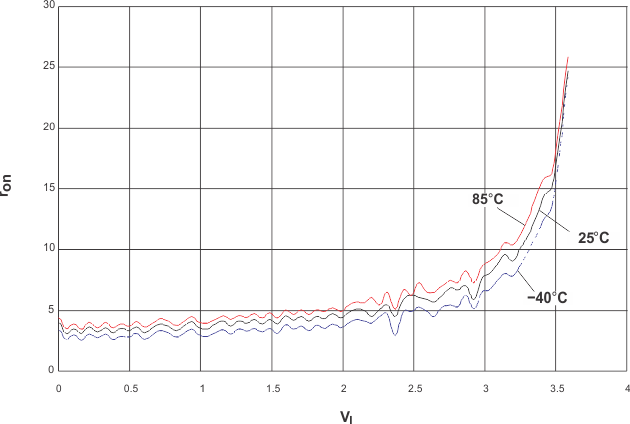SCDS008M May 1993 – June 2015 SN74CBT16214
PRODUCTION DATA.
- 1 Features
- 2 Applications
- 3 Description
- 4 Revision History
- 5 Pin Configuration and Functions
- 6 Specifications
- 7 Parameter Measurement Information
- 8 Detailed Description
- 9 Application and Implementation
- 10Power Supply Recommendations
- 11Layout
- 12Device and Documentation Support
- 13Mechanical, Packaging, and Orderable Information
Package Options
Refer to the PDF data sheet for device specific package drawings
Mechanical Data (Package|Pins)
- DGG|56
- DL|56
Thermal pad, mechanical data (Package|Pins)
Orderable Information
6 Specifications
6.1 Absolute Maximum Ratings
over operating free-air temperature range (unless otherwise noted)(1)| MIN | MAX | UNIT | |||
|---|---|---|---|---|---|
| VCC | Supply voltage | –0.5 | 7 | V | |
| VI | Input voltage(2) | –0.5 | 7 | V | |
| Continuous channel current | 128 | mA | |||
| IIK | Input clamp current, (VI < 0) | 50 | mA | ||
| Tstg | Storage temperature | –65 | 150 | °C | |
(1) Stresses beyond those listed under Absolute Maximum Ratings may cause permanent damage to the device. These are stress ratings only, which do not imply functional operation of the device at these or any other conditions beyond those indicated under Recommended Operating Conditions. Exposure to absolute-maximum-rated conditions for extended periods may affect device reliability.
(2) The input and output negative-voltage ratings may be exceeded if the input and output clamp-current ratings are observed.
6.2 ESD Ratings
| VALUE | UNIT | |||
|---|---|---|---|---|
| V(ESD) | Electrostatic discharge | Human body model (HBM), per ANSI/ESDA/JEDEC JS-001(1) | ±1000 | V |
| Charged-device model (CDM), per JEDEC specification JESD22-C101(2) | ±1500 | |||
(1) JEDEC document JEP155 states that 500-V HBM allows safe manufacturing with a standard ESD control process.
(2) JEDEC document JEP157 states that 250-V CDM allows safe manufacturing with a standard ESD control process.
6.3 Recommended Operating Conditions
over operating free-air temperature range (unless otherwise noted)(1)| MIN | MAX | UNIT | ||
|---|---|---|---|---|
| VCC | Supply voltage | 4 | 5.5 | V |
| VIH | High-level control input voltage | 2 | V | |
| VIL | Low-level control input voltage | 0.8 | V | |
| TA | Operating free-air temperature | –40 | 85 | °C |
(1) All unused control inputs of the device must be held at VCC or GND to ensure proper device operation. Refer to the TI application report, Implications of Slow or Floating CMOS Inputs, SCBA004.
6.4 Thermal Information
| THERMAL METRIC(1) | SN74CBT16214 | UNIT | ||
|---|---|---|---|---|
| DGG (TSSOP) | DL (SSOP) | |||
| 56 PINS | 56 PINS | |||
| RθJA | Junction-to-ambient thermal resistance | 64 | 56 | °C/W |
(1) For more information about traditional and new thermal metrics, see the Semiconductor and IC Package Thermal Metrics application report, SPRA953.
6.5 Electrical Characteristics
over recommended operating free-air temperature range (unless otherwise noted)| PARAMETER | TEST CONDITIONS | MIN | TYP(1) | MAX | UNIT | |||
|---|---|---|---|---|---|---|---|---|
| VIK | VCC = 4.5 V, | II = –18 mA | –1.2 | V | ||||
| II | VCC = 0, | VI = 5.5 V | 10 | µA | ||||
| VCC = 5.5 V, | VI = 5.5 V or GND | ±1 | ||||||
| ICC | VCC = 5.5 V, | IO = 0, | VI = VCC or GND | 3 | µA | |||
| ∆ICC(2) | Control inputs | VCC = 5.5 V, | One input at 3.4 V, | Other inputs at VCC or GND | 2.5 | mA | ||
| Ci | VI = 3 V or 0 | 4 | pF | |||||
| Cio(OFF) | VO = 3 V or 0, | S0, S1, and S2 = GND | 7.5 | pF | ||||
| ron(3) | VCC = 4 V, TYP at VCC = 4 V |
VI = 2.4 V, | II = 15 mA | 14 | 20 | Ω | ||
| VCC = 4.5 V | VI = 0 | II = 64 mA | 4 | 7 | Ω | |||
| II = 30 mA | 4 | 7 | ||||||
| VI = 2.4 V, | II = 15 mA | 6 | 12 | |||||
(1) All typical values are at VCC = 5 V (unless otherwise noted), TA = 25°C.
(2) This is the increase in supply current for each input that is at the specified TTL voltage level rather than VCC or GND.
(3) Measured by the voltage drop between the A and B terminals at the indicated current through the switch. ON-state resistance is determined by the lower of the voltages of the two (A or B) terminals.
6.6 Switching Characteristics
over recommended operating free-air temperature range, CL = 50 pF (unless otherwise noted) (see Figure 2)| PARAMETER | FROM (INPUT) |
TO (OUTPUT) |
VCC = 4 V | VCC = 5 V ± 0.5 V | UNIT | ||
|---|---|---|---|---|---|---|---|
| MIN | MAX | MIN | MAX | ||||
| tpd(1) | A or B | B or A | 0.35 | 0.25 | ns | ||
| tpd | S | B or A | 15.3 | 5.5 | 13.9 | ns | |
| ten | S | A or B | 16 | 5.1 | 14.5 | ns | |
| tdis | S | A or B | 12.1 | 3.6 | 11.7 | ns | |
(1) The propagation delay is the calculated RC time constant of the typical ON-state resistance of the switch and the specified load capacitance, when driven by an ideal voltage source (zero output impedance).
Typical Characteristics
over operating free-air temperature range (unless otherwise noted) Figure 1. rON vs. VI, VCC = 5 V
Figure 1. rON vs. VI, VCC = 5 V